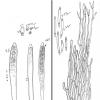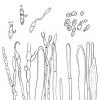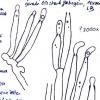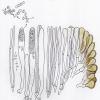
31-12-2025 19:27
Collected from loamy soil, at waterside (completel

30-12-2025 16:44
Pascal DucosBonjour,Une anamorphe rose stipitée, très nombre

30-12-2025 17:14
 Bernard CLESSE
Bernard CLESSE
Bonjour à toutes et tous,Pourriez-vous aider Albe

29-12-2025 10:15
Hulda Caroline HolteHello, I found and collected this propoloid ascom

30-12-2025 09:04
Hello.A Pyrenomycete sprouting sparsely but very d

29-12-2025 17:44
Isabelle CharissouBonjour,J'aimerais savoir si d'autres personnes au

12-11-2021 00:03
Lepista ZacariasHi everybody,A week ago in my fiels trip I noticed
Helicogonium et un anamorphe
Hermosilla Carlos Enrique,
24-12-2007 17:04
Et je me demande si celui-ci peut être anamorfo d'Helicogonium puisque je ne sais(puisque je connais aucun).
amitiés
Carlos
Hans-Otto Baral,
24-12-2007 21:34

Re:Helicogonium et un anamorphe
Dear Carlos
Nice collection and drawing! About the anamorph I can say little. I never saw an anamorph of Helicogonium with such long conidia, but why not. To identify the teleomorph needs some further characters: The ascus base looks like arising from croziers but it could also be a subbasal protuberance without connection. So it is important to look also for the ascogenous hyphae just below the ascus cell if there are true croziers present with a complete arch. Further, the small conidia that arise from the ellipsoid ascospores should be studied at the stage when they are formed, because usually they emerge at the wider end of the clavate ascospores but sometimes at the narrower end. In your case, the ascospores look ellipsoid: are they always without a clear broader and narrower end, i.e. +/- homopolar?
These two states occur in the hymenium of a Mollisia? Are there paraphyses present and perhaps also some Mollisia-asci? Is it a lignicolouos Mollisia?
The asci and host remind me of H. mollisiophilum, but I cannot remember to have seen such a bifurcate ascus base here.
best regards
Zotto
Nice collection and drawing! About the anamorph I can say little. I never saw an anamorph of Helicogonium with such long conidia, but why not. To identify the teleomorph needs some further characters: The ascus base looks like arising from croziers but it could also be a subbasal protuberance without connection. So it is important to look also for the ascogenous hyphae just below the ascus cell if there are true croziers present with a complete arch. Further, the small conidia that arise from the ellipsoid ascospores should be studied at the stage when they are formed, because usually they emerge at the wider end of the clavate ascospores but sometimes at the narrower end. In your case, the ascospores look ellipsoid: are they always without a clear broader and narrower end, i.e. +/- homopolar?
These two states occur in the hymenium of a Mollisia? Are there paraphyses present and perhaps also some Mollisia-asci? Is it a lignicolouos Mollisia?
The asci and host remind me of H. mollisiophilum, but I cannot remember to have seen such a bifurcate ascus base here.
best regards
Zotto
Hermosilla Carlos Enrique,
25-12-2007 14:54
Re:Helicogonium et un anamorphe
Tres grand merci Zotto, je vais regarder une autre fois tous ça avec tes documents dans DVD (grand valeur). Mollisia lignicolous, taxa posiblement pas decrit; anamorfo exento, pas dans l'hymenium, il y a un subiculum noir, sur le subiculum Mollisia et l'anamorphe et une tres petit Urceolla (pas etudié encore, Ungicularia ou similar).
Amitiés
Carlos
Amitiés
Carlos
Hermosilla Carlos Enrique,
25-12-2007 22:58
Re:Helicogonium et un anamorphe
J'ai des nouvelles observations, une autre anamorphe, cette fois dans les Mollisia, cette fois ce Helicogonium et je pense l'autre du autre dessins c'est une autre chose.
Dans quelques apotecia il y a asques helicogonium mais aussi quelques asques Mollisia, il y a aussi des parafises (toujours) et il ya l'anamorphe (pas comun). J'ai une autre dessing 2005 je crois.
amitiés
Carlos
Dans quelques apotecia il y a asques helicogonium mais aussi quelques asques Mollisia, il y a aussi des parafises (toujours) et il ya l'anamorphe (pas comun). J'ai une autre dessing 2005 je crois.
amitiés
Carlos
Hans-Otto Baral,
26-12-2007 12:03

Re:Helicogonium et un anamorphe
Cher Carlos
yes, the left side of your drawing should be the anamorph of the asci right, while the paraphyses among them belong to the Mollisia.. The spores drawn above the asci, did you see them within the asci? Are they germinating ascospores? I never saw a phialide on the ascospores as I recall, always the conidia were formed directly on the ascospores. About the spores on the left I am a bit unsure where they belong. Helicogonium-anamorphs produce minute conidia (similar as there ascoconidia) from terminal phialides. See the attach (Helic. parorbiliopsidis)
Zotto
yes, the left side of your drawing should be the anamorph of the asci right, while the paraphyses among them belong to the Mollisia.. The spores drawn above the asci, did you see them within the asci? Are they germinating ascospores? I never saw a phialide on the ascospores as I recall, always the conidia were formed directly on the ascospores. About the spores on the left I am a bit unsure where they belong. Helicogonium-anamorphs produce minute conidia (similar as there ascoconidia) from terminal phialides. See the attach (Helic. parorbiliopsidis)
Zotto
Hermosilla Carlos Enrique,
26-12-2007 13:48
Re:Helicogonium et un anamorphe
Exact, a gauche c'est l'anamorfo.
Oui, à l'intérieur de l'asques je vois l'ascospores et peux voir à l'intérieur et exterieur (charrues d'ascas accidentel ?) la formation de conidies.
J'envoie un dessin de 2005
Au moins pour mon cela c'est une avance, maintenant j'ai placé l'anamorfo réel d'Helicogonium avec le votre aide
Amitiés
Carlos
Oui, à l'intérieur de l'asques je vois l'ascospores et peux voir à l'intérieur et exterieur (charrues d'ascas accidentel ?) la formation de conidies.
J'envoie un dessin de 2005
Au moins pour mon cela c'est une avance, maintenant j'ai placé l'anamorfo réel d'Helicogonium avec le votre aide
Amitiés
Carlos
Hans-Otto Baral,
26-12-2007 23:51

Re:Helicogonium et un anamorphe
A possibility would be Helicogonium prunicolae, a species I have seen only once, in Mollisia prunicola. It has rather broad ascospores and asci with croziers. But the ascoconidia are cylindrical, not ovoid as in your drawing. Did you try to identify the Mollisia? What is the host of the Mollisia?
Zotto
Zotto






